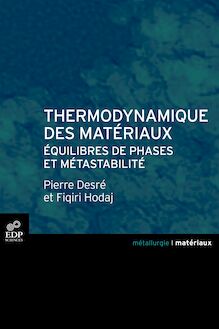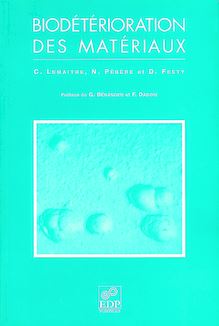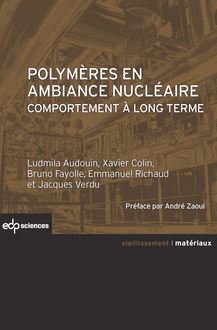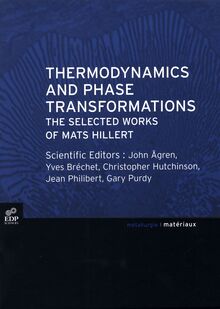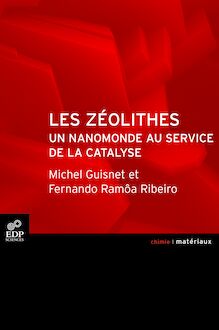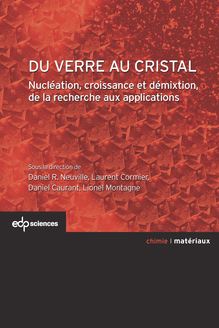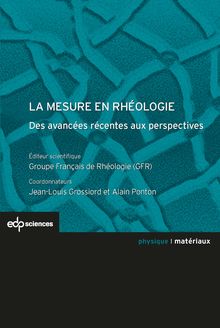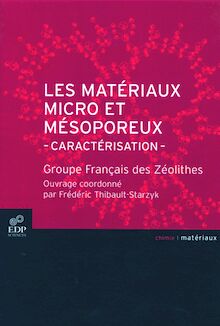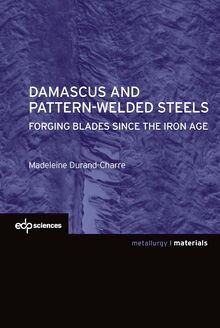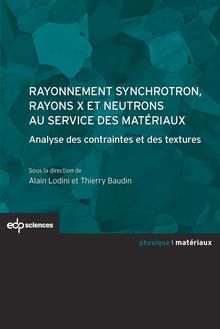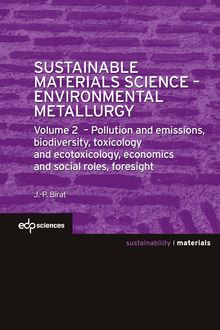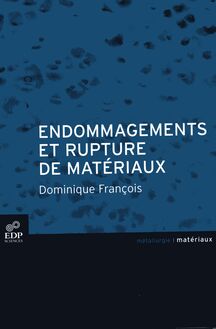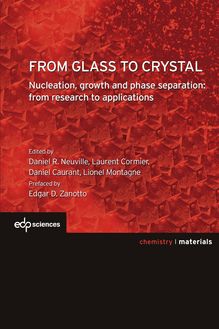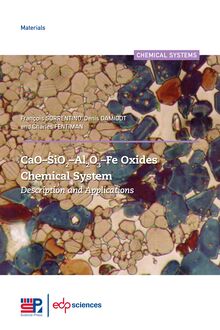From glass to crystal , livre ebook
665
pages
English
Ebooks
2017
Obtenez un accès à la bibliothèque pour le consulter en ligne En savoir plus
Découvre YouScribe en t'inscrivant gratuitement
Découvre YouScribe en t'inscrivant gratuitement
665
pages
English
Ebooks
2017
Obtenez un accès à la bibliothèque pour le consulter en ligne En savoir plus
Publié par
Date de parution
16 mars 2017
Nombre de lectures
2
EAN13
9782759819973
Langue
English
Poids de l'ouvrage
17 Mo
Glass-ceramics are now commonplace in our daily lives, despite having only been discovered for less than a century. Much still remains to be investigated and understood about these materials, both in their applications as well as in the underlying scientific concepts. This book aims to contribute to this objective, providing a complete overview on these materials. It presents an update on the recent developments concerning the mechanisms of nucleation, crystal growth and phase separation, bringing together theoretical aspects and characterization methods. It also covers current and future applications of a large variety of glass-ceramics.
The book comprises three main parts. The first proposes an assessment of the various theories on nucleation, growth and phase separation in glassy systems. The second describes microscopic and spectroscopic analytical tools and focuses on recent advances applied to the characterization of glass-ceramics. The last part presents different families of glass-ceramics (oxides, oxyfluorides, chalcogenides) and their applications in many areas (optics, biomedical, domestic, artistic, storage of hazardous wastes...).
This reference book is destined to students (Master, PhD levels…), lecturers, researchers, engineers, at university or in industry, or just those of us who are curious and keen to discover the exciting world of transformation of glass into these “hybrid” glass-ceramic materials, arising through this apparently simple glass to crystal transformation...
Publié par
Date de parution
16 mars 2017
Nombre de lectures
2
EAN13
9782759819973
Langue
English
Poids de l'ouvrage
17 Mo
FROM GLASS TO CRYSTAL
Nucleation, growth and phase separation:
from research to applications
Edited by
Daniel R. Neuville, Laurent Cormier, Daniel Caurant, Lionel Montagne
Glass-ceramics are now commonplace in our daily lives, despite having only been discovered for less than a FROM GLASS TO CRYSTAL SS TYST
century. Much still remains to be investigated and understood about these materials, both in their applications
as well as in the underlying scientifi c concepts. This book aims to contribute to this objective, providing a
complete overview on these materials. It presents an update on the recent developments concerning the Nucleation, growth and phase separation: mechanisms of nucleation, crystal growth and phase separation, bringing together theoretical aspects and
characterization methods. It also covers current and future applications of a large variety of glass-ceramics. from research to applicationsThe book comprises three main parts. The fi rst proposes an assessment of the various theories on
nucleation, growth and phase separation in glassy systems. The second describes microscopic and spectroscopic
analytical tools and focuses on recent advances applied to the characterization of glass-ceramics. The last
part presents different families of glass-ceramics (oxides, oxyfl uorides, chalcogenides) and their applications
in many areas (optics, biomedical, domestic, artistic, storage of hazardous wastes...).
This reference book is destined to students (Master, PhD levels…), lecturers, researchers, engineers, at
university or in industry, or just those of us who are curious and keen to discover the exciting world of
transformation of glass into these “hybrid” glass-ceramic materials, arising through this apparently simple glass
to crystal transformation...
Edited by Daniel R. Neuville, IPGP-CNRS Senior Research Director, studies the thermodynamic and rheological properties of
glasses, crystals and melts by linking their structure at high temperature to the macroscopic properties, applications Daniel R. Neuville, Laurent Cormier, ranging from Earth to materials sciences.
Laurent Cormier, CNRS Senior Research Director, studies the structural properties of oxide glasses and liquids to Daniel Caurant, Lionel Montagnebetter understand nucleation and, in particular, the role of nucleating agents in the formation of the glass-ceramics.
Daniel Caurant, Researcher scientist at the CNRS, focuses on the relationship between composition, structure and Prefaced byproperties of oxide glasses and studies the solubilization and dispersion of certain specifi c elements in glass matrices.
Lionel Montagne, Professor at the University of Lille 1, investigates glasses and glass-ceramics based on phos- Edgar D. Zanottophates or silicates using solid-state NMR. He develops glasses for non-conventional applications such as self-healing
seals or alternative matrices for nuclear wastes.
ISBN : 978-2-7598-1783-2 / 120 €
www.edpsciences.org
9 782759 817832
materials I chemistry chemistry I materials
9782759817832_COUV.indd 1 10/02/2017 10:05
FROM GLASS TO CRYSTAL
Daniel R. Neuville, Laurent Cormier, Daniel Caurant, Lionel Montagne FROM GLASS TO CRYSTAL
Nucleation, growth and phase
separation, from research
to applicationsFROM GLASS TO CRYSTAL
Nucleation, growth and phase
separation, from research
to applications
Editors
Daniel R. Neuville, Laurent Cormier,
Daniel Caurant, Lionel MontagneEDP SCIENCES
EDP Sciences Ltd
Hamilton House, Mabledon Place, Bloomsbury, London WC1H 9BB, UK
EDP Sciences SA
17, Avenue du Hoggar, PA de Courtabœuf, F-91940 Les Ulis, France
Published in France by EDP Sciences SA, Les Ulis
www.edpsciences.org
© EDP Sciences 2017
This work is subject to copyright. All rights are reserved, whether the whole or part of the
material is concerned, specifcally the rights of translation, reprinting, re-use of
illustrations, recitation, broad-casting, reproduction on microflms or in other ways, and storage
in data bank. Duplication of this publication or parts thereof is only permitted under the
provisions of the French Copyright law of March11, 1957. Violations fall under the
prosecution act of the Frencw.
Printed in France.
ISBN 978-2-7598-1783-2Contents
Preface . . . . . . . . . . . . . . . . . . . . . . . . . . . . . . . . . . . . . . . . . . . . . . . . 1
Foreword . . . . . . . . . . . . . . . . . . . . . . . . . . . . . . . . . . . . . . . . . . . . . . 5
Introduction . . . . . . . . . . . . . . . . . . . . . . . . . . . . . . . . . . . . . . . . . . . 7
Contributors . . . . . . . . . . . . . . . . . . . . . . . . . . . . . . . . . . . . . . . . . . 9
Main symbols and physical constants . . . . . . . . . . . . . 13
Abbreviations . . . . . . . . . . . . . . . . . . . . . . . . . . . . . . . . . . . . . . . . . 15
Main crystalline phases considered in this book . 17
Chapter 1: The classical nucleation theory . . . 19
1.1. From devitrifcation… . . . . . . . . . . . . . . . . . . . . . . . . . . . . . . . . . 20
1.2. … to the origins of CNT. . . . . . . . . . . . . . . . . . . . . . . . . . . . . . . . 21
1.3. Homogeneous nucleation . . . . . . . . . . . . . . . . . . . . . . . . . . . . . . . 22
1.3.1. Thermodynamic considerations . . . . . . . . . . . . . . . . . . . . . . 22
1.3.2. Kinetic considerations . . . . . . . . . . . . . . . . . . . . . . . . . . . . 25
1.3.3. Nucleation rate . . . . . . . . . . . . . . . . . . . . . . . . . . . . . . . . . 26
1.3.4. Examples of glasses with homogeneous nucleation . . . . . . . . . 27
1.4. Heterogeneous nucleation . . . . . . . . . . . . . . . . . . . . . . . . . . . . . . 29
1.5. Induction time . . . . . . . . . . . . . . . . . . . . . . . . . . . . . . . . . . . . . . . 31
1.6. Crystal growth. . . . . . . . . . . . . . . . . . . . . . . . . . . . . . . . . . . . . . . . 33
1.6.1. Crystal growth rate. . . . . . . . . . . . . . . . . . . . . . . . . . . . . . . 33
1.6.2. Crystalline morphology . . . . . . . . . . . . . . . . . . . . . . . . . . . . 35
1.6.3. Constraints on crystals 38
1.6.4. Ostwald ripening. . . . . . . . . . . . . . . . . . . . . . . . . . . . . . . . 38
1.6.5. TTT diagram . . . . . . . . . . . . . . . . . . . . . . . . . . . . . . . . . . 39
1.7. CNT facing experiments . . . . . . . . . . . . . . . . . . . . . . . . . . . . . . . 40II From Glass to Crystal
1.8. Ostwald’s rule. . . . . . . . . . . . . . . . . . . . . . . . . . . . . . . . . . . . . . . . 41
1.9. Conclusion . . . . . . . . . . . . . . . . . . . . . . . . . . . . . . . . . . . . . . . . . . 42
Chapter 2: Beyond the classical
nucleation theory . . . . . . . . . . . . . . . . . . . . . . . . . . . . . . . . . . . . 43
2.1. Cluster dynamics . . . . . . . . . . . . . . . . . . . . . . . . . . . . . . . . . . . . . 43
2.2. Density functional theory (DFT). . . . . . . . . . . . . . . . . . . . . . . . . . 45
2.3. Validity of the Stokes-Einstein equation? . . . . . . . . . . . . . . . . . . . 47
2.4. Models of non-classical nucleus . . . . . . . . . . . . . . . . . . . . . . . . . . 47
2.4.1. Introduction of a fractal surface . . . . . . . . . . . . . . . . . . . . . 48
2.4.2. Diffuse interface theory (DIT) . . . . . . . . . . . . . . . . . . . . . . . 49
2.4.3. Experimental observations of the critical nucleus? . . . . . . . . . 50
2.5. Non-homogeneous disordered system 51
2.5.1. Nucleation theory in systems with static local disorder . . . . . . . 51
2.5.2. Recent experimental observations . . . . . . . . . . . . . . . . . . . . . 53
2.6. Generalized Gibbs’s approach . . . . . . . . . . . . . . . . . . . . . . . . . . . 54
2.6.1. Simplifed theoretical description . . . . . . . . . . . . . . . . . . . . . 54
2.6.2. Implications for nucleation/growth . . . . . . . . . . . . . . . . . . . 57
2.6.3. Experimental observations of metastable nucleation . . . . . . . . 60
2.7. Two-step model . . . . . . . . . . . . . . . . . . . . . . . . . . . . . . . . . . . . . . 62
2.7.1. Description of the two-step model 62
2.7.2. vations. . . . . . . . . . . . . . . . . . . . . . . . . . 64
2.8. Conclusion . . . . . . . . . . . . . . . . . . . . . . . . . . . . . . . . . . . . . . . . . . 65
Chapter 3: Thermodynamics of the glassy
and the crystalline states – General kinetics
of return to equilibrium . . . . . . . . . . . . . . . . . . . . . . . . . . . . . 67
3.1. Stability and instability: application to oxide glasses. . . . . . . . . . . 68
3.1.1. Stability and postulates of thermodynamics . . . . . . . . . . . . . . 68
3.1.2. The stability condition – Back to equilibrium. . . . . . . . . . . . . 71
3.1.3. Application to the specifc case of the spinodal decomposition
(cf. also chapter 4). . . . . . . . . . . . . . . . . . . . . . . . . . . . . . . 73
3.1.4. Generalization . . . . . . . . . . . . . . . . . . . . . . . . . . . . . . . . . 75
3.2. Experimental methods for the determination
of thermodynamic quantities at the equilibrium of a stable
or metastable oxide glass or crystal . . . . . . . . . . . . . . . . . . . . . . . 77
3.2.1. Overview of thermodynamic measurable quantities. . . . . . . . . 77Contents III
3.2.2. Measurement of enthalpy increment, heat capacity and
transition enthalpy . . . . . . . . . . . . . . . . . . . . . . . . . . . . . . 81
3.2.3. Measurement of the formation or mixing functions . . . . . . . . . 91
3.2.4. ement of free enthalpy and derivative quantities by
Knudsen Effusion Mass Spectrometry (KEMS) . . . . . . . . . . . 98
3.2.5. Importance of coupling the methods . . . . . . . . . . . . . . . . . . . 101
3.3. Parameters characterizing the metastable vitreous state . . . . . . . . 103
3.3.1. Thermodynamical description of the glass transition 103
3.3.2. The fctive temperature and its measurement . . . . . . . . . . . . . 106
3.3.3. Confgurational entropy at 0 K and its measurement . . . . . . . 108
3.3.4. Kinetic approach of the glassy transition – order parameter
